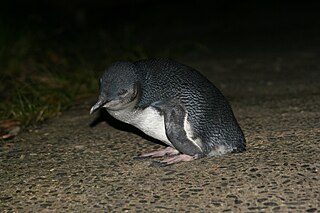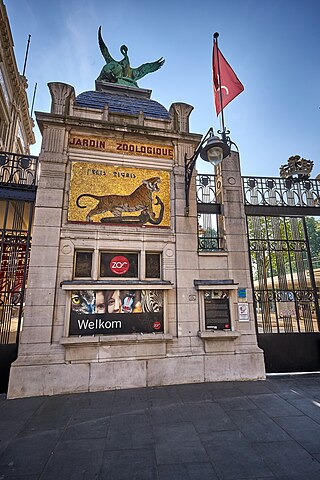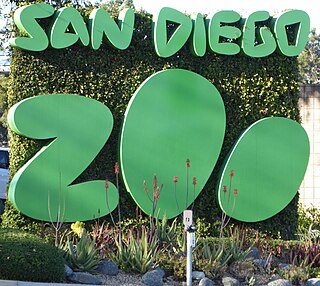Related Research Articles

The little penguin is a species of penguin from New Zealand. They are commonly known as little blue penguins or blue penguins owing to their slate-blue plumage and are also known by their Māori name kororā, and their Boonwurrung name Djinan Yawa-dji Goyeep.

Ex situ conservation literally means, "off-site conservation". It is the process of protecting an endangered species, variety or breed, of plant or animal outside its natural habitat; for example, by removing part of the population from a threatened habitat and placing it in a new location, an artificial environment which is similar to the natural habitat of the respective animal and within the care of humans, example are zoological parks and wildlife sanctuaries. The degree to which humans control or modify the natural dynamics of the managed population varies widely, and this may include alteration of living environments, reproductive patterns, access to resources, and protection from predation and mortality. Ex situ management can occur within or outside a species' natural geographic range. Individuals maintained ex situ exist outside an ecological niche. This means that they are not under the same selection pressures as wild populations, and they may undergo artificial selection if maintained ex situ for multiple generations.

Artificial insemination is the deliberate introduction of sperm into a female's cervix or uterine cavity for the purpose of achieving a pregnancy through in vivo fertilization by means other than sexual intercourse. It is a fertility treatment for humans, and is a common practice in animal breeding, including dairy cattle and pigs.

Taronga Zoo is a zoo located in Sydney, New South Wales, Australia, in the suburb of Mosman, on the shores of Sydney Harbour. The opening hours are between 9:30 a.m. to 4:30 p.m. Taronga is an Aboriginal word meaning "beautiful view".
Insemination is the introduction of sperm into a female’s reproductive system for the purpose of impregnating, also called fertilizing, the female for sexual reproduction. The sperm is introduced into the uterus of a mammal or the oviduct of an oviparous (egg-laying) animal. In mammals, insemination normally occurs during sexual intercourse or copulation, but insemination can take place in other ways, such as by artificial insemination.

Semen collection refers to the process of obtaining semen from human males or other animals with the use of various methods, for the purposes of artificial insemination, or medical study. Semen can be collected via masturbation, prostate massage, artificial vagina, penile vibratory stimulation (vibroejaculation) and electroejaculation. Semen can be collected from endangered species for cryopreservation of genetic resources.

Antwerp Zoo is a zoo in the centre of Antwerp, Belgium, located next to the Antwerpen-Centraal railway station. It is the oldest animal park in the country, and one of the oldest in the world, established on 21 July 1843.

Captive breeding, also known as captive propagation, is the process of keeping plants or animals in controlled environments, such as wildlife reserves, zoos, botanic gardens, and other conservation facilities. It is sometimes employed to help species that are being threatened by the effects of human activities such as climate change, habitat loss, fragmentation, overhunting or fishing, pollution, predation, disease, and parasitism.

The World Association of Zoos and Aquariums (WAZA) is the "umbrella" organization for the world zoo and aquarium community. Its mission is to provide leadership and support for zoos, aquariums, and partner organizations of the world in animal care and welfare, conservation of biodiversity, environmental education and global sustainability.

The northern white rhinoceros or northern white rhino is one of two subspecies of the white rhinoceros. Formerly found in several countries in East and Central Africa south of the Sahara, this subspecies is a grazer in grasslands and savanna woodlands. Since 19 March 2018, there are only two known rhinos of this subspecies left, called Najin and Fatu, both of which are female; barring the existence of unknown or misclassified male northern white rhinos elsewhere in Africa, this makes the subspecies functionally extinct. The two female rhinos belong to the Dvůr Králové Zoo in the Czech Republic but live in the Ol Pejeta Conservancy in Kenya and are protected round-the-clock by armed guards.
Robert Hermes is a veterinarian researcher at The Leibniz-Institute of Zoo and Wildlife Research in Berlin. He studied veterinary medicine at the Freie Universität Berlin. He completed a Ph.D. in reproductive management.

The Cheetah Conservation Fund is a research and lobby institution in Namibia concerned with the study and sustenance of the country's cheetah population, the largest and healthiest in the world. Its Research and Education Centre is located 44 kilometres (27 mi) east of Otjiwarongo. The CCF was founded in 1990 by conservation biologist Laurie Marker who won the 2010 Tyler Prize for her efforts in Namibia.
Genetic erosion is a process where the limited gene pool of an endangered species diminishes even more when reproductive individuals die off before reproducing with others in their endangered low population. The term is sometimes used in a narrow sense, such as when describing the loss of particular alleles or genes, as well as being used more broadly, as when referring to the loss of a phenotype or whole species.

A frozen zoo is a storage facility in which genetic materials taken from animals are stored at very low temperatures (−196 °C) in tanks of liquid nitrogen. Material preserved in this way can be stored indefinitely and used for artificial insemination, in vitro fertilisation, embryo transfer, and cloning. Some facilities also collect and cryopreserve plant material.

JoGayle Dillon Howard was an American zoologist and theriogenologist specializing in the captive breeding of endangered species such as pandas, clouded leopards, and black-footed ferrets.
Rebecca Spindler is the head of science and conservation at non-profit conservation organisation Bush Heritage Australia. She previously was the manager of research and conservation at Taronga Conservation Society Australia, in the New South Wales Office of Environment and Heritage (OEH).

Cryoconservation of animal genetic resources is a strategy wherein samples of animal genetic materials are preserved cryogenically.

Terri Lynn Roth is the vice president of Conservation and Science at the Cincinnati Zoo and Botanical Garden. Additionally, she is the director of the Center for Conservation and Research of Endangered Wildlife (CREW). She has made several breakthroughs in the captive breeding of Sumatran rhinoceroses, a critically endangered species with fewer than 300 left.
David Edwin Wildt was an American wildlife biologist, who worked at the Smithsonian Institution's National Zoo and Conservation Biology Institute (SCBI) for almost 40 years. He pioneered research in wildlife reproductive physiology, and became instrumental in rescuing species which would have otherwise gone extinct due to dwindling population sizes. The species he may have helped "save" from extinction included cheetahs, lions, African antelopes, black-footed ferrets, while his work included first time artificial inseminations of the clouded leopard, puma, snow leopard, tiger, Eld's deer, scimitar-horned oryx, Persian onager, and the Przewalski's horse.
Thomas B. Hildebrandt is a German veterinarian researcher dedicated to species conservation. He heads the Department of Reproduction Management at the Leibniz Institute for Zoo and Wildlife Research (IZW) in Berlin and holds a full professorship for Wildlife Reproduction Medicine at the veterinary faculty of the Freie Universität Berlin.
References
- 1 2 3 "Research Team". Seaworld. Retrieved 4 June 2018.
- ↑ O'Brien, J.K.; Catt, S.L.; Ireland, K.A.; Maxwell, W.M.C.; Evans, G. (June 1997). "In vitro and in vivo developmental capacity of oocytes from prepuberal and adult sheep". Theriogenology. 47 (7): 1433–43. doi:10.1016/S0093-691X(97)00134-9.
- ↑ "Sperm Bank and Reproductive Research Could Help Save Tasmanian Devils from Extinction". Scientific American. Platt, John R. 14 December 2011.
- ↑ Burks, Robin (11 August 2011). "SeaWorld's first test tube penguin is born". Tech Times.
- ↑ "Sea World Has First Successful Artificial Insemination Of Animal With Penguin 184". KDrama Stars. 16 October 2014.
- ↑ MacBeath, Nicky (14 August 2014). "World's first test-tube penguin born". The Press and Journal. Retrieved 1 November 2014.
- ↑ "Regulatory Subcommittee". International Embryo Transfer Society. Retrieved 1 November 2014.
- ↑ "Home Page". Association of Zoos & Acquariums.